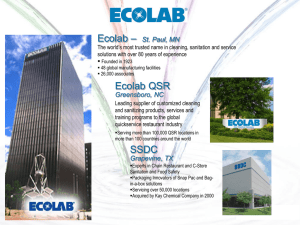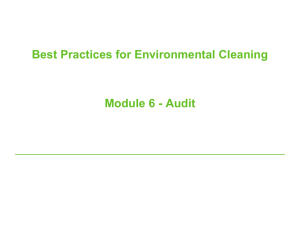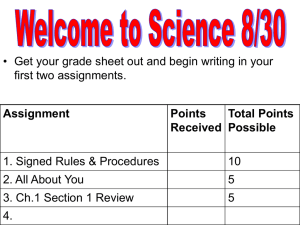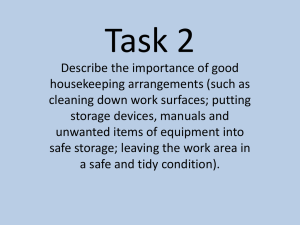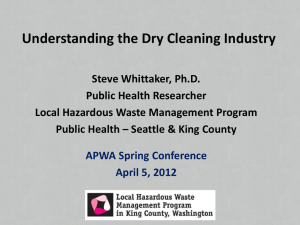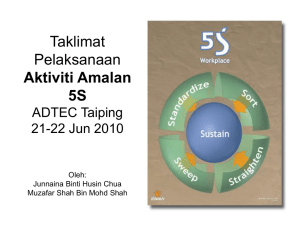SMTAI Technical Forum Cleaning Optimization 9-22-04 - AAT
advertisement
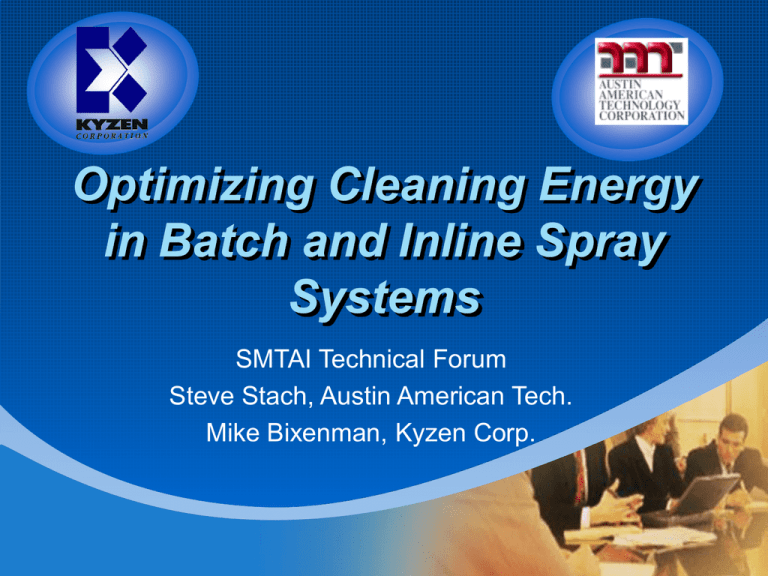
Optimizing Cleaning Energy in Batch and Inline Spray Systems SMTAI Technical Forum Steve Stach, Austin American Tech. Mike Bixenman, Kyzen Corp. Agenda 1. Technology Advancements 2. Research Questions 3. Theoretical Framework 4. Conceptional Framework Introduction • The benefit of a well defined cleaning process: – improves manufacturing efficiencies – increases process yields • Optimized process – cleaning agent effective on wide range of soils – integration of machine with chemistry – mechanical design delivers chemistry at the heart of the residue – control and re-use of fluids Challenges • Converge of circuit boards and die packaging technologies – higher performance electronic devices • Technical issues: – – – – low standoff fine pitch solder bump arrays ionics trapped underneath active components spacing between conductors may pose risk of electromigration Statement of Problem • Staying ahead of the ever-advancing technology curve: – – – – industry challenged to improve cleaning processes increased complexity of board and geometry new solder paste and flux formulations improved performance at lower cost • Mechanical and chemical energy are the key variables to meeting demands Technology Advancements • New approaches to mechanical energy deliver: – performance at the heart of the residue rather than the tail of the delivery system • Advanced cleaning chemistry designs: – – – – – lower operating temperature lower concentration long bath life bright and shinny solder joints no sump side adds Statement of Purpose • The purpose of this work is developing an equation that will allow optimal spray configuration and impingement pressure at the board level, to improve cleaning performance. Research Questions • What kind of equations defines surface energy at board level? • How does this affect the fluid delivery design in a cleaning system? • How much impingement pressure is needed at the board level? • Which is better, higher pressure or high flow? Study Hypothesis • H1: Understanding the dynamics of flow, pressure, and dissolution, a physical equation to determine impingement pressure to penetrate under densely populated components can be defined. Theoretical Framework • Manufacturing is judged by: – Time and material metrics • consistently achieving product quality standards at the lowest possible cost • process optimization increases production while lowering cost • Spray in air inline cleaning systems – modeling to predict performance • solubility rate to the residue in the cleaning solution • physical energy available in the cleaning system Conceptional Model Rp=Rs+Rd Process cleaning rate equation Rp Process Cleaning Rate Rs Static Cleaning Rate Rd Dynamic Cleaning Rate Process Cleaning Rate Equation • Units will vary depending on residue • Rates for cleaning flux residue: – Expressed as • • • • • thickness or mass removed/second volume flushed/second mass removed/second solder balls/second particles/second • Rates are temperature dependent Defining an Optimized System • Spray-in-air reduce time by: – Increasing the Rd component • maximizing physical energy delivered at the surface to be cleaned • Optimized spray-in-air – not overpowered or oversized – delivers necessary chemistry and energy to clean the most difficult or sensitive areas, at a rate that will meet the process time requirement using minimal chemistry, energy and floor space consumption The Rs+Rd Balance • Key to predicting optimized process performance – understanding the nature of the soil and the chemical and physical needs for removing it Rates of Rinsing and Drying • Equation also applies in the rinsing and drying cycles • Rinsing cycle – removal of wash fluid – dissolved or suspended soils • Dryer – evaporation – displacement • Displacement of water by air preferred – 100-1000 times longer to evaporate than to displace Rs + Rd = Rp • Rd cleaning processes – inline “air spray” – planarized batch • Rs cleaning processes – dip tanks – spray under immersion – dishwasher – vapor degreasers Cleaning process comparison System D esign Static Im m ersion D ish W asher Planarized B atch Inline A ir Spray W ash % Rs 100% %Rd 0% 70% R inse %Rd 0% 30% % Rs 100 % 70% 30% 70% 20% 80% D ry %Rd 0% 30% % Rs 100 % 50% 40% 60% 20% 80% 20% 80% 2% 98% 50% Important Differences in Designs • Dishwasher style – shadowing of parts – 3 dimensional racking • Inline & planarized batch – higher % Rd – board surfaces tangent to the direction of spray – less shadowing = S had ow ed area = circuit b oards Types of Surface Energy • Energy available at the the cleaning surface • Energy measured in ergs for mass – 1 Joule = 107 ergs = 0.239 calories = .73ft lbs. =2.78x10-7 kW hrs • Velocities measure in grams and centimeters – force measured in dynes – force exerted by one gram accelerated by earth’s gravity for one cm. – 1 lb. / in2 = 68948 dynes / cm2 Spray in Air Systems • Cleaning requires energy to displace a fluid across a distance to create the force sufficient to achieve rate of cleaning • Fluid flow is created by spray impingement pressure, gravity drainage, and capillary action S o u rce S u rfa ce E n erg y of R ange E n erg y A v a ila b le of G o v ern in g E q u a tio n C ap illary actio n 0 -2 ” w c (0 -1 .0 p si) Pc = 2 γ / R G ravity F lo w 0 -1 ” w c (0 -0 .5 p si) Pg = ρ g h Im p in ge m ent P ressure 0 -2 7 5 ” w c (0 -1 0 p si) P i = ½ (rv ) . . . 2 Surface Tension & Capillary Action • Think of surface tension as: – balloon of sorts surrounding the cleaning fluid – If it is thin and weak • cleaning fluid easily moves in and out of tight spaces – If the side wall is thick and strong • cleaning fluid will resist flow into tight spaces • Capillary attraction or repulsion is a resultant force of – adhesion – cohesion – surface tension • Equation 2: Interfacial pressure differential (for planes) – Δp = 2γ / R • Equation 3: Interfacial pressure differential (for tubes) – Δp = γ / R • Where γ = surface tension; R = radius meniscus Interfacial Pressure Difference • Capillary forces can work for and against • They can facilitate the initial wetting of tight spaces • They can inhibit rinsing and drying steps by resisting displacement forces if insufficient • Graph #1 indicates it would take an air jet impingement force of greater than 1-psi to displace water trapped in spaces less than 1-mil Interfacial p ressure d ifference at eq uilib riu m 10 1 p si 0 .1 0 .0 1 G ap /d iam eter, m ils 0 20 P lanar C ylind er 40 60 Calculating Surface Energy • Cleaning fluids can have both potential and kinetic energy • Potential energy of one unit volume of fluid at rest2 (Equation 4) – Ep = p*g*h where: • p = density of fluid • g = acceleration due to gravity = 9800 cm/sec/sec • h = height of fluid (cm) • Kinetic energy of on unit volume of cleaning fluid in motion2 (Equation 5) – Ek =1/2 pv2 where: • p = density of fluid • v = velocity of jet Solving Equations 4 & 5 for water systems • Reveals two important points – potential energy is small as compared to kinetic energy – Ek is driven by v2 • can be maximized by nozzle and pump design • basis for not purchasing equipment solely based on horsepower • If jets or nozzles are not optimized for the pump and stand off distance, excessive splash or spray atomization can retard the energy delivered by reducing impingement velocity Manifold Efficiency • Optimum – delivers energy of the pump efficiently over distance with minimal losses – efficiency measured by dividing the impingement pressure at maximum working distance by the manifold pressure – average spray manifold efficiency • 5-10% of existing inline spray cleaning systems – high efficiency designs • >25% increased surface energy – improves cleaning by 2x to 10x Bernoulli Equation Modifications • Total pressure of fluid in pipe is equal to static pressure plus the kinetic and potential energy • Equation 6: Pe + ½ ρv2 + ρgh = total pressure where: – – – – – Pe = internal pressure energy ρ = density of fluid v = velocity of fluid g = acceleration due to gravity = 9800 cm/sec/sec h = height of fluid (cm) • Applied to unrestrained jet striking the cleaning surface by removing the internal pressure energy factor Pe and adding the surface energy effect of capillary action Modified Bernoulli Equation • Modified for surface cleaning energy – Equation 7: ½ ρv2 + ρgh + 2γ /R = total force at tightest gap – where • R is the contact radius of the meniscus in the gap • R will have a negative value if meniscus is convex instead of concave – the impact of negative force at any step • will not penetrate • overall cleaning rate will be zero in the gap Spray System Nozzle Design • Nozzles create jets that carry the energy to the surface of part • Design and layout of nozzles is an important step in optimizing cleaning process • Equation 5 give the Kinetic energy to the surface of the board – contains both mass and velocity of the jet • Conical and fan nozzles – spread the spray to cover larger areas at t he expense of reducing the mass per unit and velocity of the jet • Coherent jets – hold together longer and deliver more energy to a smaller area requiring more nozzles and a higher overall flow rate S p ray T yp e T yp ical p ressu re @ 2 ”,5 0 p si m an . /P ressu re lo ss/in 2 p si / ~50% d ro p /in ch In d icated u se C o nical 0 .4 p si / ~75% d ro p /in ch W id est co v erag e area, lo w est k in etic en erg y, flo od in g ap p licatio n s C o herent 1 0 p si / ~25% d ro p /in ch S m allest co v erag e, h ig h est en erg y d en sity o v er lo n g est d istan ce F an/D elta W id e co v erag e, o v erlap p in g h igh im p in g e m en t fo r clo se w o rk d istan ce Spray System Nozzle Design • All jets break-up and slow down over distance in air • Coherent hold together longer – provides the maximum energy transfer per unit area – overlapping jets can be an effective strategy for increasing surface energy density as long as the splash at the surface does not dampen the impact force Empirical Measurements Impingement/flow data of coherent jet vs. fan M anifo ld P ressure Im p in ge m ent p si @ C o verage w id th @ 0 .0 7 5 ”C o herent Jet 1” 2” 4” 1 .5 ” 4 .0 ” 30 40 50 60 15 17 19 20 10 12 13 15 6 .5 8 9 .5 11 0 .6 0 .6 0 .6 0 .6 0 .7 0 .7 0 .8 0 .8 3 .2 4 .4 6 .0 7 .2 1 .6 1 .8 2 .3 2 .5 0 .2 0 .3 0 .5 0 .5 1 .5 1 .7 1 .7 1 .8 3 .2 5 3 .6 0 4 .0 4 .0 p sig p sig p sig p sig F lo w : (gp m ) 0 .6 9 0 .8 2 0 .8 9 0 .9 7 F 4 0 -1 .0 F an N o zzle 30 40 50 60 p sig p sig p sig p sig 0 .8 9 1 .0 6 1 .2 0 1 .3 0 Cleaning rates • Inline and planar racked batch cleaning can be significantly improved by – designing coherent jets – combination of fan-jets and coherent jets • In addition – coherent jets in dryers offer considerable improvement in effectiveness Inline Cleaning, Jets and Timing • Timing and sequence in a cleaning process is critical – Pre-wash: • thoroughly wet the parts with wash solution chemistry • provide sufficient flow and contact time to bring the assembly to wash temperature – facilitates full static-cleaning rate Rs – Wash • part should see several high impingement scourings punctuated by brief soak periods • static rate is optimized by maintaining wash chemistry • dynamic rate is optimized by focusing on maximum physical energy at the part surfaces Inline Cleaning, Jets and Timing – Chemical Isolation • ample impingement force in air manifold to wipe chemistry from part • wet iso uses laminar flow to remove wash chemistry – Power Rinse • series of high pressure nozzles removes and dilutes remaining ions using DI-water – Final Rinse • low flow/pressure final pure rinse of DI water • final soak to remove ionic contamination • Ionic cleanliness of a clean part = final rinse purity – Dry • high-speed air displacement Dishwashers are Different • Different form planar type batch and inline cleaners • Most efficient when designed for maximum flow, not impingement, as potential energy and capillary forces must be relied upon for cleaning surface energy in the shadowed areas • Too high pressure atomizes the spray – reduces jet velocity – must farther distance – increases the splash interference with other jets • Optimized jets provide large cohesive droplets using low pressure jets – adhere rather than bounce or splash – more consistent and thorough cleaning in shadowed areas • Shadowing is minimized through fixturing Solubility's Contribution • “Dissolve-it” – age old, tried and true – augmented with heat, blasting and scrubbing Very Soluble • Rate of solubility – dependent on dissolution rate – temperature effect in dissolving residue – concentration of solvent needed to dissolve residue Temp Soluble Marginal Solubility Dissolution Rate Distinctive Residue Types • Very soluble (Top line) – finger salts – water soluble flux residue • High solubility (Middle line) – – – – increasing temperature increases solubility (typically) increased temperature reduces cleaning time soft flux residue rosin • Marginal solubility (Bottom line) – requires heat and physical energy – hard residue flux – no-clean flux Equation 8: Rs = Dr x Tc x Cc • Dr: dissolution rate • Tc: the effect of temperature in dissolving residue • Cc: concentration of cleaning chemistry • Easily determined experimentally by – weighing residue dissolved in fixed period of time – ratio of temperature divided by rate at lower temperature – dividing the rate of dissolution in as a function of cleaning chemistry concentration Contamination Effect • Remember: like dissolve like – generally true for most solvent systems – not true for all cleaning solutions or applications • saponification – cleaning agent is depleted over time • not true for marginally soluble salts or weak organic acids • contamination of wash bath in these cases slows cleaning process by shifting the chemical equilibrium of the wash solution – consider the dynamics of the system • chemical loss on average – 10-25% evaporative – 50-90% drag out into rinse – make-up in the bath prolongs life Equation 9: Pka=[anion][cation]/[residue] • Ionization potential (Pka) – complexities arise when residues contain multiple constituents • some have high solubility • some have low solubility – dissolving the soluble constituents may leave behind insoluble constituents as a physical residue requiring significant time and/or physical energy to remove Conclusion • Science of optimizing spray-in-air requires – accurate model to predict performance • All cleaning systems are governed by two fundamental principles: – the solubility rate of the residue for the cleaning solution – physical energy available in the cleaning system – maximizing the physical energy delivered to the surface increases the dynamic cleaning rate • Understanding the static cleaning rate plus the dynamic cleaning rate balance is key in predicting optimization Conclusion • Surface energy – energy available at the cleaning surface to do the work – Modified Bernoulli equation • may be used to calculate surface energy • In spray-in-air system – work of cleaning requires energy to displace a fluid across a distance to create the force sufficient to achieve the rate of cleaning – low surface tension easily moves fluid in an out of tight spaces – Capillary forces work for and against since they work for wetting but inhibit rinsing – Understanding fluid potential and kinetic energy allows for nozzle and pump configuration that maximizes surface energy – Manifold efficiency can increase surface cleaning by as much as 25% Conclusion • Design and layout of nozzles is an important step in optimization • Conical and fan nozzles spread the spray to cover larger areas • Coherent jets hold together longer giving maximum energy transfer per unit area • Overlapping jets can be an effective strategy for increasing surface energy density Conclusion • Rate to chemical dissolution can be augmented with various forms of physical assistance such as heating, impingement, and time. • Contamination loading can slow the cleaning process by shifting chemical equilibrium • Chemical dynamics stead state when make up exceed soil load Follow on Research • Phase II will prove hypothesis with practice – will prove of nullify research hypothesis – study design will focus on solubility rate of the cleaning solution at static rate – once cleaning solution rate is known, how will it be improved applying physical energy to the board surface? – The DOE will test the effect of energy applied to the board surface – Logic tells us that a known dissolution rate will allow for an equation that will allow an engineer to calculate cleaning time and distance Authors • Steve Stach - Austin American Technology – sstach@aat-corp.com • Mike Bixenman - Kyzen Corporation – mike_bix@kyzen.com


